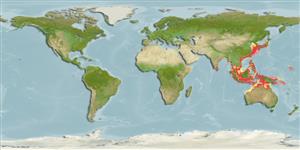>
Eupercaria/misc (Various families in series Eupercaria) >
Sparidae (Porgies)
Etymology: Argyrops: Greek, argyros = silver, silvered + Gree, ops = appearance (Ref. 45335).
Eponymy: Dr Pieter Bleeker (1819–1878) was an ichthyologist and army surgeon commissioned (1841) by the Dutch East India Company. [...] (Ref. 128868), visit book page.
Environment: milieu / climate zone / depth range / distribution range
Ecologia
marinhas; estuarina demersal; intervalo de profundidade 50 - 200 m (Ref. 124569). Tropical
Western Pacific: Japan to Australia.
Tamanho / Peso / Idade
Maturity: Lm ? range ? - ? cm
Max length : 50.0 cm SL macho/indeterminado; (Ref. 124569); common length : 30.0 cm SL macho/indeterminado; (Ref. 124569)
Descrição suscinta
Chaves de identificação | Morfologia | Morfometria
Espinhos dorsais (total) : 10 - 11; Raios dorsais (total) : 9 - 11; Espinhos anais: 3; Raios anais : 8 - 9. This species is distinguished from all its congeners by the following set of characters: body deep and compressed; D XI,10 (rarely X,11); first dorsal-fin spine rudimentary (one dorsal-fin spine on first dorsal pterygiophore), the second to sixth spines (usually 5, rarely 4) are much elongated and flattened in juveniles 15-25 cm SL (second spine often reaching beyond level of last dorsal soft rays, shorter and reaching first soft dorsal-fin ray base in specimens of ca. 30 cm SL); orbit diameter clearly less than suborbital depth; pupil diameter greater than preorbital length in specimens less than 20 cm SL, but pupil diameter is clearly less than preorbital length (more noticeable in specimens greater than approx. 30 cm SL; the rear margin of upper jaw extends to a vertical beyond orbit diameter; body bars reddish, often present to 25 cm SL; all fins reddish hyaline (Ref. 124569).
Inhabits sandy and muddy bottoms (Ref. 41299). Important food fish. In Okinawa (Japan), according to local fishermen, this species usually reches more thatn 50 cm SL and a buyer from Ryukyu Is. reported that some individuals occasionally attain 65 cm SL (Ref. 124569).
Ciclo de vida ou comportamento de acasalamento
Maturidade | Reprodução | Desova | Ovos | Fecundidade | Larvas
Iwatsuki, Y. and P.C. Heemstra, 2018. Taxonomic review of the genus Argyrops (Perciformes; Sparidae) with three new species from the Indo-West Pacific. Zootaxa 4438(3):401-442. (Ref. 124569)
Status na Lista Vermelha da UICN (Ref. 130435: Version 2024-1)
Ameaça para os humanos
Harmless
Uso pelos humanos
Pescarias: espécies comerciais
Ferramentas
Relatórios especiais
Baixar XML
Fontes da internet
Estimates based on models
Preferred temperature (Ref.
123201): 17.4 - 28.2, mean 26.4 °C (based on 780 cells).
Índice de diversidade filogenética (Ref.
82804): PD
50 = 0.5625 [Uniqueness, from 0.5 = low to 2.0 = high].
Bayesian length-weight: a=0.02089 (0.00983 - 0.04439), b=2.96 (2.78 - 3.14), in cm total length, based on LWR estimates for this (Sub)family-body shape (Ref.
93245).
Nível Trófico (Ref.
69278): 4.5 ±0.8 se; based on diet studies.
Resiliência (Ref.
120179): Baixo, tempo mínimo de duplicação da população 4,5 - 14 anos (Preliminary K or Fecundity.).
Fishing Vulnerability (Ref.
59153): Moderate vulnerability (44 of 100).
